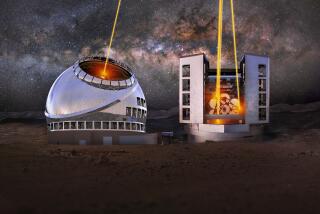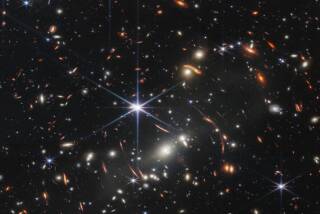Massive mirror to be cast for telescope 10 times sharper than Hubble
Technicians on Saturday will fire up a furnace in Arizona to more than 2,000 degrees Fahrenheit to pour glass to fabricate a mirror 27 feet in diameter that will be part of a giant telescope with 10 times the resolution of the Hubble Space Telescope.
The mirror, which will weigh about 20 tons, will take a full year to polish to within 1/20 the wavelength of light, a tolerance on the scale of about 1 in 10 billion.
âLetâs imagine you took this mirror and you enlarged it to the physical size of the United States. The tallest mountain on that surface would be 1 inch tall,â said Michael Long, vice president of GMTO Corp., the nonprofit organization based in Pasadena that is coordinating the Giant Magellan Telescope project. âSo itâs incredibly tight tolerances that have to be maintained, even when the mirror is in the telescope itself.â
The mirror is the third of an eventual seven that will be cast and polished at the University of Arizonaâs Steward Observatory Mirror Laboratory. The seven eventually will be configured to give the telescope an aperture of 80 feet, and allow operators to correct for diffraction of light by Earthâs atmosphere and achieve close to the theoretical maximum resolution, a feat once thought to be achievable only from space.
The Giant Magellan Telescope is expected to be fully operational in Chileâs Atacama Desert by 2022. It will eventually work in concert with existing and planned telescopes, both in space and on Earth, including the Large Synoptic Survey Telescope, which is expected to be fully operational the same year, and NASAâs James Webb Space Telescope, scheduled for launch in 2018.
âWe expect to be able to make observations and spectrographic studies of the first stars that formed after the Big Bang,â Long said. âWeâll be able to observe the earliest galaxies, as those stars assembled, and answer the question, when did black holes arrive? Did they arrive with the early galaxies or did they arrive later?â
In addition, Long said, the telescope will be able to examine Earth-sized planets orbiting nearby stars.
One mirror has been completed and has met the tight design specifications, while a second is entering the polishing phase, Long said.
The mirrors are made of borosilicate glass poured into a rotating furnace that will give the honeycombed mirror surface an asymmetric shape similar to that of water swirled in a bucket.







